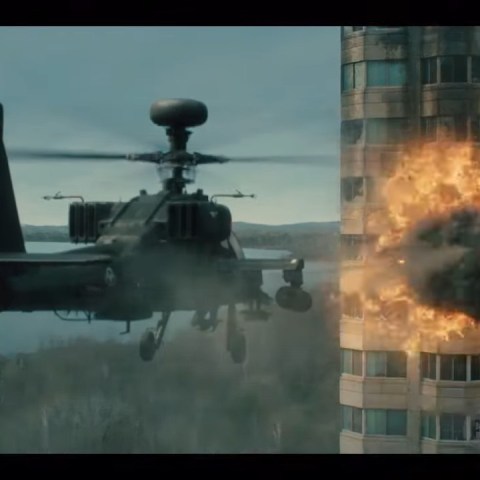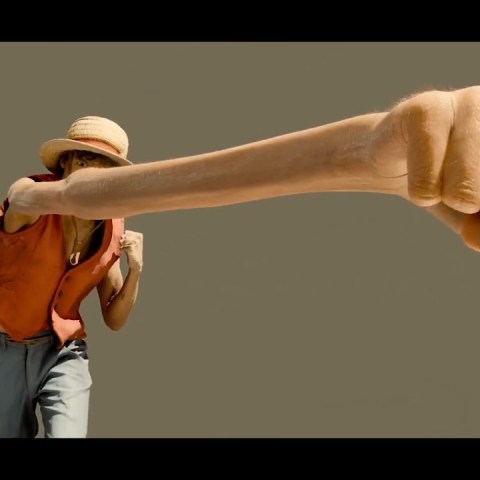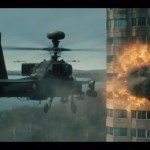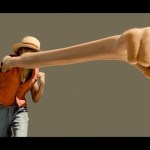Framestore animation supervisor Nicholas Tripodi breaks down the art of bringing Ted to life on TV.
Seth MacFarlane first created Ted about a magical teddy bear who lives with his best friend John for a feature film in 2012. A sequel, Ted 2, arrived in 2015, and now the franchise has also become a Peacock streaming series.
Along the way, MacFarlane has entrusted the team at Framestore in Melbourne (previously Iloura, then Method Studios) to help craft the CG bear. Animation supervisor Nicholas Tripodi has been along for the ride from the beginning, also, even working on early tests before the first film.
Here, Tripodi shares the details behind the performance of Ted, which includes not only Xsens MVN suit capture of MacFarlane, but also capture by members of the Framestore team, who then build on that mocap to animate the character–a challenging feat given the limited facial features Ted has.
Find out more in this befores & afters interview.
b&a: It’s incredible the longevity you’ve had with Ted projects, Nick. That goes right back to tests on the first Ted movie, right?
Nicholas Tripodi: Yes, we shot a test in South Melbourne on the streets there and basically convinced Seth that we were the people to help bring his bear to life. I think when he saw it, he was like, ‘This is our bear.’ It was a pretty special moment for us to lock into what Seth was hoping to get out of Ted. It was a collaboration with Tippett Studio, as well, of course, on that film, and as the films continued and into the TV series, we’ve taken on a larger chunk of the work.

b&a: Even going back to those tests, what do you think it was about what your team captured for Seth with the character that made him react like that?
Nicholas Tripodi: I think what really sold it to him was just the natural subtlety of Ted, just the idea that Ted has been living with John in this world his whole life. It’s not a novelty anymore. He just exists in there. They are two people who have a conversation, they’re best mates, and it’s about that natural chemistry they have. It’s not necessarily about caricature or overacting or being super dynamic with that. It’s more about just that intimate familiarity that these two best friends have, and making that feel as natural a discourse as possible. That’s always been big on our agenda, not treating Ted in a special way. He’s another actor. He’s as real as all the other actors in the scene. We didn’t try to differentiate him in that way.
b&a: Right, and I’ve also thought, it’s a very different kind of CG challenge than Framestore might be used to doing.
Nicholas Tripodi: Yeah, it is. What we’re really trying to do is just channel Seth’s personality and his performance into this bear. It’s not necessarily about a creature or an effect. It’s as if we’re putting Seth inside that teddy bear and delivering his performance in the best way we possibly can.
We’ve learnt a lot of shorthand along the way. Obviously, we can’t just plug in the mocap and we’re done translating Seth. Sometimes there are these complex mannerisms and expressions that just don’t go into such a limited palette that Ted is, I mean, we can’t even move his eyes. So, trying to make all that good stuff read is important. It’s been a long journey. Obviously, we’ve gotten more and more sophisticated with that as we’ve had more time with Ted.

b&a: So, tell me a bit about the workflow as it exists now with, say, getting plates and starting animation, compared to what it was before. I know that for the first film, Seth was even doing some on-set Xsens motion capture, which was perhaps not done as much live for the second film, and then on this TV series it was kind of done separately. Plus they used the visualization tool ViewScreen on set.
Nicholas Tripodi: In some ways, it’s largely remained the same. On the first Ted, it was the early days of the Xsens MVN suit and the quality was very poor, to be frank. We could just gather some timings from it and that’s about it, really. Whereas the suits these days are fantastic. The data we have to begin with is a much better starting point.
We didn’t have a lot of exposure to the visualization tool, but there was a level of trust with our history with the character. We knew what to do and we also had really great stuffy passes as well. They’d run the bear on set and use eyeline tools, so we know where roughly to place Ted.
This time around we then spent a lot of time fine tuning our retargeting process between the mocap data to Ted. It’s definitely not a straight transfer. You have to make some compromises and the stride length is a big one. Oftentimes, the human stride lengths transposed onto Ted wouldn’t be sufficient. So we would often do a bunch of pickup shoots as well, and put our own mocap in, particularly for the locomotion stuff. We’d be walking super fast, almost speed walking, which would allow Ted to keep up with John, if they’re moving through his place.
So, yes, the mocap was not done live. Seth was a very busy man on set and I think it just felt like he wasn’t going to be able to give his best performance on top of everything else he was doing. I think in the end it worked out really well. Once he had time to edit the sequences, think about his performance, he would get into a little room with the mocap setup and run through it. He would actually be miming to dialogue and he did a great job. It’s actually remarkable how well he was able to keep sync, so to speak.
Of course, we were shifting things around a little bit to help out, but he did a great job and it just meant his performance was a little more considered at times. The flip side of all of that is, he essentially was performing on the spot. He was in a fairly small room. He wasn’t necessarily moving through space. So that’s where we would come in and either keyframe or shoot our own mocap to make that work.

b&a: And I assume you’re also pulling from a ton of animation sources–from video reference, mocap, your own mocap performances?
Nicholas Tripodi: Yes, the distillation process, that is, taking out the extraneous performance and leaving just the core of what’s there, was really important with Ted. Like I said, because his palette is so limited in terms of what he could do with his face, it means we just followed that classic rule: communication. We had to ask ourselves, ‘What’s the one key thing you want to communicate in this shot? Then that’s King, and everything else is secondary. So often with Ted, we’d find the funniest line deliveries were always the most paired back ones, the simplest ones. Less is more with Ted a lot of the time. He could just be staring blankly and that would be so funny in the context of what’s happening rather than trying to overdo it, or sometimes just one little expression really sells it.
b&a: He’s often in shock or mock shock or something like that, which I like because he’s quite still faced. What have you got at your disposal, facial animation wise? Obviously, he has a nose area with the small mouth and then he’s got two big eyebrows. And you mentioned his eyes don’t move.
Nicholas Tripodi: We’ve got the muzzle, first. We could move the mouth around. The nose, we didn’t have anything. It got pulled around by what the jaw was doing, just the nature of the fabric pull. We had squints, so they were really important. That was one of our main tools to get expression out of the eyes. We don’t necessarily want to show them too much, but what we do is, maybe we would start a shot with that squint tension there and release it on a surprise moment. You perceive those eyes as opening up even though they’re not, coupled with the brow lift as well.
But we really had nothing for the eyes. We could blink, but only in special cases. It would have to be called out by Seth pretty much, to close the eyes. It was a very rare thing. And then the brows. The brows were probably one of the most important things we had to work with Ted, but it was all about balance. We didn’t want to have Ted be too expressive with the brows.

b&a: There are things that Ted does that are just funny inherently. You mentioned just not doing much or staring, but even his smaller limbs where he runs with them or lifts them up to tell–I find that funny. You’ve already mentioned the blank looks, but tell me about inserting comedy into the performance.
Nicholas Tripodi: With the blank looks, a blank look could look lifeless as well, so you have to be so careful with that. How can he be alive, but still be blank? And just one other note on the facial stuff is, because we didn’t have eye controls to do glances, so much of that came from head tilts and head movements. Head darts or head tiles became the analogy for eye darts. We also tried to find other ways to communicate what people do so subtly and expressively with their eyes.
But in terms of full body comedy, one thing was, Ted’s comfortable in his world. It is not like, ‘Oh, there’s a chair there. Let’s make a big kind of song and dance about it.’ He can get up and down a chair. The thing is, it requires different mechanics and I think there’s something inherently funny about that. It’s cute, but he’s so not. He’s such a foul bear, but he’s doing these things that are kind of cute.
We also try not to be slapstick with him. That’s something that generally, we don’t do. Although, there are a couple of times where he’s running away down the stairs and he slips and falls, and he bounces on his butt down the stairs. Another time he gets caught for giving John pot and Blaire’s chasing him down the stairs, and he ends up on the roof. For that, we did look at some of the Buster Keaton reference. Seth was amazing with his references. He’d just pull out the most obscure references for what he expected this shot to be. He was just like a film encyclopedia.
We would have to go look up who the hell was that that he was referencing. And it was always spot on. He knew what he wanted a lot of the time. That’s a beautiful thing about working for Seth. He’s such a pleasure to work for in that regard. He’s very clear about what he wants. He has a real shorthand as well, in terms of how he talks about the notes. Plus he has a real respect for the craft, too. I think he appreciates what can and can’t be done.

b&a: Technology-wise, I imagine you’re animating a puppet in Maya and some people might suggest that it’s a pretty simple character compared to, as we say before, these crazy creatures that Framestore often has to do. But I’m curious what animators see? Are they mostly working with a grayscale version of Ted or is it something where you can get something quite detailed in there to work with, since he doesn’t have hugely complex fur?
Nicholas Tripodi: It is a pretty short groom, so it wasn’t too bad. Often we’d have what we call a proxy rig, the calamari rig. That’s just a broken up piece of mesh that runs super fast. It definitely plays a big, big value on getting real-time playback in Maya. From there we’d have a cutdown density version of the mesh and we’d also have a switch to inflate the mesh to what we would consider the groom level, to put a little plush on him.
Because he spent a lot of time sitting on the ground or on the couch, we also had deformers attached to the rig that we could hook up to other bits of geo, like the couch, that would flatten his butt out and also pose specific blend shapes. So for instance, when he’s sitting on the couch, he wouldn’t have a nice flat line on the bottom edge of his legs as they’d touch the couch. There’d be a bit of a bridge. We’d call it the Golden Gate Bridge, a little space there where we had a blend shape that would flatten that out.
We would build in specific shapes. Ted doesn’t really have a neck, for instance. How his head and shoulders work together, and how much twist and fabric push and pull there was, was something we had to sort. Then we’d have particular shapes we’d wind in for any sort of potential volume loss.
From there, we’d often set off temp renders that would give us an indication of the fur. We’d get light rigs from lighting that we would build. These would be a similar-ish lighting environment to what lighting would have. We’d have all the motion blur settings up, of course, which let us check our pre-roll and post roll and any sort of fast actions, particularly motion blur with Ted’s lip sync. I guess with most lip sync in general, it’s hugely important for animators to be able to visualize the motion blur when you’re trying to get a correct lip seal. If you only have a one frame lip seal–then you’ve got open, close, open–the motion blur is going to blend that lip seal out and you’re not going to actually read it. So you’ve got to make sure either your motion blur settings are set to account for that, or you’re taking into account that you might need a two frame lip seal.
Finally we also have cloth sims that go over the body. It’s amazing how much that adds, particularly if he turns his head or his chest, you see those flex lines striped through his chest as the material twists. All that stuff adds a huge amount to the final product.

b&a: Can you pinpoint one shot or sequence with Ted that was the toughest to pull off? Maybe it was something quite subtle, or a bigger moment?
Nicholas Tripodi: In terms of difficulty, the shot where Blaire and Ted are leaving the Halloween party and they’re walking down the steps. It’s a very long flight of steps with landings and they’re drunk and it’s a complex mix of different things to overcome there. We had to shoot our own mocap for that. We had to make it look like Seth’s performance. So a lot of the gestures we were mimicking as best we could, but we had to travel Ted down these stairs that he’s not really designed to travel down and keep up to speed with Blaire, who’s talking to him a lot. So the eyelines had to be correct and make it all feel completely natural. It is just the most normal thing in the world. I think that’s where the difficulty really lay, was not making a meal of Ted having to go down any steps to walking. It’s just two friends walking down having that natural discourse.
Then, my favorite thing we did with Ted was, well, it was super-short. It was when they were faux-adopting the bully and they became the ‘dads’. They realize it’s all gone wrong and at one point Ted is telling John off and he’s just being so incredulous, like, ‘What the fuck have you done?’ I felt like we delivered it with such beautiful punch. It had that real kind of thrust to it and I was really, really proud of that, those couple of shots. And they’re like 20 frame shots, that’s it.
b&a: When you say you did our own mocap for that staircase scene, does that mean it was actually you, Nick, doing that?
Nicholas Tripodi: Yes, myself and Dean Elliott did the mocap for Ted. We’ve done it in the past. We do a lot of that. We have our own Xsens suits which meant the data fed in the exact same manner. There were no real differences there, it’s the same retargeting. Both Dean and I have worked on Ted from the start, so we’ve become pretty good at mimicking Seth to the point where it’s hopefully pretty invisible.

b&a: The final thing I just wanted to ask you about was the fact that you’re doing this for television. But I imagine it’s still a huge amount of work, maybe more than on a film.
Nicholas Tripodi: Yeah, we did around 2,400 shots in a year. It was giant. It was the biggest shot count we’ve done as a company, I believe. We were pumping it out. It was fast-paced work. We had to be so efficient. I’m really proud of that actually, how quick we got at it and all the processes that we put in place, just to make sure artists could get in and animate the shot and do a good job of that and not have to worry so much about the technical side of it.
And it was really one of those shows where the team came out of it just so happy. We had such a fun time. The reviews were a blast, we’re laughing in reviews because the content was so fun to work with and we didn’t want it to end, to be honest. Even after 2,400 shots, we’re like, ‘Let’s keep going!’.


















